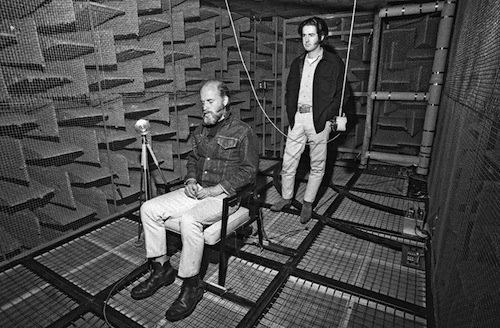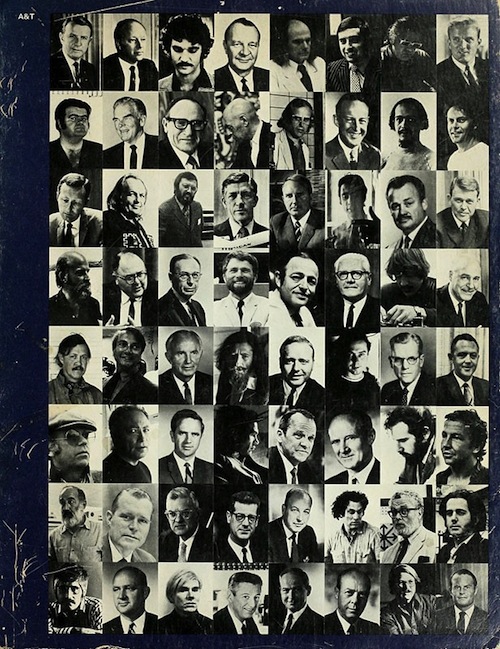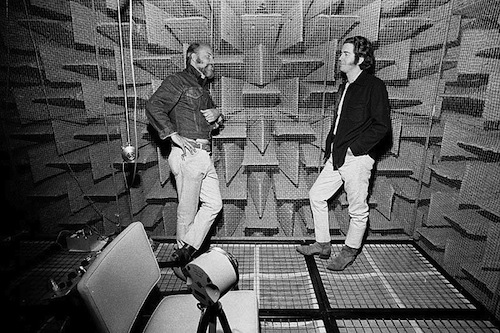100 Artists is a yearlong celebration of the 100 artists who have appeared to date in Art21′s award-winning film series Art in the Twenty-First Century. Throughout 2013, we are dedicating two to three days to each artist on our social media platforms—Twitter, Facebook, Tumblr, and here on the Art21 Blog. Our current featured artist is James Turrell.

James Turrell and Robert Irwin in the anechoic chamber during their collaboration with Garrett Corporation. Courtesy Los Angeles County Museum of Art.
Maurice Tuchman, the Los Angeles County Museum of Art’s first modern art curator, went down to Torrance, California one day in July of 1969. Associate curator Jane Livingston and assistant curator Gail Scott came with him, and all three underwent “alpha conditioning.”
Artists James Turrell and Robert Irwin had designed alpha conditioning and a series of other experiments with Dr. Ed Wortz of the Garrett Corporation as part of LACMA’s Art and Technology Program (1967-1971). The initiative and resulting exhibition—”this hair-raising idea,” Livingston called it in retrospect [1]—involved pairing artists with corporations and asking artists to collaborate with company scientists or engineers. At the time, Tuchman said he imagined artists moving around corporations as if in their own studios.
“I believed it was the process of interchange between artist and company that was most significant, rather than whatever tangible results might quickly occur,” Tuchman wrote in 1970 [2]. But a later interview with Irwin, as well as early reports on the processes of other artists in the program, suggest Tuchman may have eased into this belief—maybe when he began to realize that only 15 or so of the 76 artist-participants would make something tangible enough to show. It’s this intangibility that makes the Art and Technology show persistently interesting: Why did corporate settings and an expanded range of hi-tech resources push artists, even those who decidedly made objects in their usual practices, toward indeterminate, impossibly conceptual projects?

Headshots of participants from the cover of the Report on Art and Technology. Courtesy Los Angeles County Museum of Art.
 For alpha conditioning, Wortz hooked the curators up, one at a time, for thirty minutes each, to an electroencephalography machine, also known as an EEG. They sat in a reclining chair—a comfortable one, as Turrell, Irwin and Wortz specify in their notes—and put on glasses with a white light attached to the rim. Then they closed their eyes. Through their eyelids, they could see the light go on each time their alpha rhythms, or brain waves, went down to 8-12 cycles per second, putting them in meditative states. The best photo from this day shows Livingston, reclining and half-smiling while Wortz puts electrodes on her forehead. She looks relaxed. But would she still be a few moments later with a machine constantly informing her how relaxed or not she was? After returning to the museum, all three curators “experienced inexplicable sensations of anxiety or a sense of mental dislocation or dissociation,” says the report Livingston later wrote.
For alpha conditioning, Wortz hooked the curators up, one at a time, for thirty minutes each, to an electroencephalography machine, also known as an EEG. They sat in a reclining chair—a comfortable one, as Turrell, Irwin and Wortz specify in their notes—and put on glasses with a white light attached to the rim. Then they closed their eyes. Through their eyelids, they could see the light go on each time their alpha rhythms, or brain waves, went down to 8-12 cycles per second, putting them in meditative states. The best photo from this day shows Livingston, reclining and half-smiling while Wortz puts electrodes on her forehead. She looks relaxed. But would she still be a few moments later with a machine constantly informing her how relaxed or not she was? After returning to the museum, all three curators “experienced inexplicable sensations of anxiety or a sense of mental dislocation or dissociation,” says the report Livingston later wrote.
Neil Armstrong walked on the moon that same July. And Wortz, who worked just south of LAX in Garrett’s Life Sciences Department, had been developing “life support systems for lunar missions” using NASA money. Trained as a psychologist, he thought often about perceptual dilemmas: Would the bigness of the lunar surface disorient an astronaut? How do you prepare yourself to step out into that much space?
It made sense that Robert Irwin and James Turrell would intrigue him. At that point, Irwin was crafting translucent white disks out of acrylic lacquer, installing overlapping groups of them against white walls. Sometimes, even when you were in front of them, it looked as though they weren’t actually there, and Irwin objected to anyone taking pictures of them. “I am concerned with specifics and reject the generalities of photographs,” Irwin told ArtForum in 1965.
Turrell had been working in the empty Mendota Hotel in Santa Monica since 1966, closing up all the windows after renting it out and experimenting with projections in corners or lights shining through cut-open walls—anything that made space look dimensional in an unfamiliar way. Both artists, as they would write together in a 1969 memo, wanted “people to perceive their perceptions.”
With Wortz as their main contact at Garrett, they experimented sensory deprivation chambers, meditation processes and ganzfields (fields of sight with no objects in them to focus on), measuring the reactions volunteers had to various sensory experiments. At first, they thought they would build some kind of sound-free anechoic chamber for the LACMA show, but reading through the notes, memos and interview transcripts from the last stretch of the project, is like watching the three men gradually disengage themselves from goals and order.

James Turrell and Robert Irwin in the anechoic chamber during their collaboration with Garrett Corporation. Courtesy Los Angeles County Museum of Art.
This has to be part of what makes the Irwin-Turrell-Wortz collaboration so fascinating: they started out wanting to manipulate perception for research purposes. But all three of them “became less inclined though spring and into summer of ‘69 to carry out [their] original plan” and more “deeply involved in the highly personal experience itself of intimate collaboration.” [3] Then Turrell abruptly “abdicated,” as both Livingston and Irwin put it, which makes it sound like Turrell had relinquished a kind of power. “All of this is very Pavlovian,” Turrell said later, vaguely explaining his abdication. “You’re not really asking much of the person, or yourself. And all you can watch are the surface responses.”
Last year, Livingston spoke on a panel at the Getty Museum and remembered with a hint of sarcasm, the goals of Art and Technology: “Here we [were] in the middle of a huge industrial complex,” she said, “and wouldn’t it be wonderful if we could maybe make the new world happen?”
Maybe they did, thoug, , or at least gave some blueprints for how art could and couldn’t interact with the corporate world. The Irwin-Turrell-Wortz collaboration—which went from a goal-oriented art-science marriage to an exiting of the corporate frame by artists and company man (Wortz would soon become a Buddhist therapist specializing in helping artists)—feels like a muscular response to the growing inability to tell where corporate interests and art and science begin.
[1] “Modern Art in Los Angeles—Women Curators in Los Angeles,” panel discussion, Getty Center, Los Angeles, October 26, 2011.
[2] Maurice Tuchman, “Introduction,” in A Report on the Art and Technology Program of the Los Angeles County Museum of Art, 1967–1971, ed. Maurice Tuchman (Los Angeles: LACMA, 1971).
[3] A Report on the Art and Technology Program of the Los Angeles County Museum of Art, 1967–1971.



